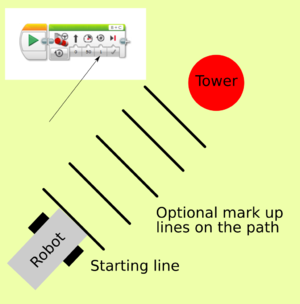The falling tower/en
From wikiluntti
<languages />
Introduction

Make a collision between a robot and a tower. The challenge is very exciting and fun. You get even more fun if the tower is located at the corner of the table, and the robot runs on a table.
The tower can be made of almost any material, eg Legos, toilet paper rolls or wooden blocks.
Aim
The pupil will learn natural numbers (ie. 1, 2, 3, . . ), and also decimal notation if the distance is suitable. Also, the angle of aiming to the target is elaborated.
Robot
Almost any robot with wheels will do.
Sensors
No sensors is used.
Example Video
Theory
The robot drives a fixed length depending on the diameter of the wheel (and the gearing ratio). Estimate the driving distance of the the robot.

Exercises
- Consider why the ancient towers are round?
- Have two tables, one for training (without the tower or any markings), and the other with tower and marks. The pupils will learn estimating.
- If the distance is larger, the aiming of the robot will be more difficult. Move the starting line farther away from the tower.
- Put the tower at the border of the table, so that if the robot runs too far, it will fall down. Usually the robot will not break, even if it drops on a floor from a table, but you may put a pillow there under.
- The green steering block can be adjusted to move according to the time, also. Thus it is possible to estimate seconds, also. Estimate how far the robot will drive in a (eg) 5 seconds.
- Observe the movement of the tire, and check how far the robot drives during one lap.
- Try different tires if you have some.

Back to Mahtavaa Matematiikkaa 2020
